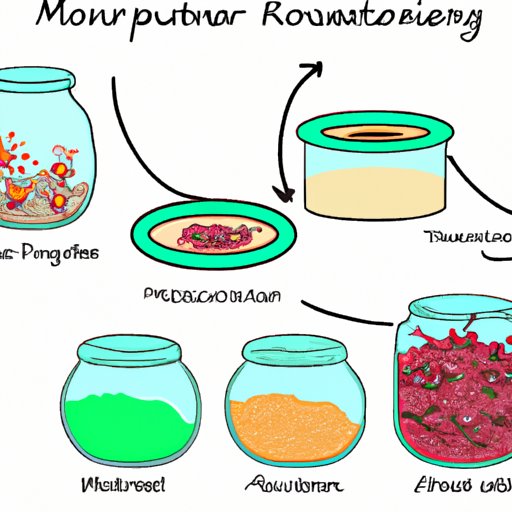I. Introduction
Hummingbirds are one of nature’s most fascinating creatures. They are beautiful, intelligent, and incredibly energetic little birds that bring joy and liveliness to any outdoor space. One of the simplest ways to attract hummingbirds to your garden is to provide them with food. While there are several store-bought options available, homemade nectar is an excellent alternative that ensures the availability of fresh and all-natural food for these little bird beauties.
II. How to Make Hummingbird Food
Making your hummingbird food couldn’t be easier, and you only need a few essential supplies:
- Sugar
- Water
- Pot
- Spoon
- Storage container
Follow these simple steps:
1. Pour water and sugar in a pot
The first step is to combine one part of white granulated sugar with four parts of water in a pot.
2. Heat the mixture until sugar dissolves
Heat the pot on the stove until the sugar dissolves completely. A gentle boil will suffice, and it should take about a couple of minutes. Refrain from boiling the mixture at high temperatures as it can affect the nectar’s consistency and compromise its nutritional value.
3. Allow it to cool down
Once dissolved, remove the pot from the heat and let it cool down. Room temperature is ideal before transferring it to the storage container.
4. Fill the storage container with the mixture
Pour the mixture into the storage container of your choice and store the nectar in your refrigerator until required. If you have excess nectar, freeze it for a maximum of three months.
III. Nutritional Breakdown of the Food
The primary ingredients in homemade hummingbird food are sugar and water. Sugar is an essential source of energy, providing the energy requirement necessary for hummingbirds to fly continuously and perform other activities essential to their survival. Water, on the other hand, is vital for hydration and helps hummingbirds maintain their body temperature.
A nutritional analysis of homemade hummingbird food shows that it contains no harmful additives such as preservatives or artificial colors and, therefore, differs significantly from store-bought nectar options that contain chemical additives and synthetic dyes that are potentially hazardous to the birds.
IV. Tips for Attracting More Hummingbirds to Your Garden
Here are several practical tips that can help increase the number of hummingbirds visiting your garden:
A. Placing Hummingbird Feeders
Locate your hummingbird feeder in an open, sunny area, preferably close to a water source, which will make it easily accessible for the birds. Also, it is crucial to place your feeder at a height that is easily visible to hummingbirds but out of reach of potential predators, such as cats or squirrels. Hummingbirds will be more attracted to feeders that resemble the red and pink flowers they feed from.
B. Planting Hummingbird-Friendly Flowers
Growing a variety of colorful, nectar-rich flowers is an excellent way of attracting hummingbirds. Some common flowers that hummingbirds love include bee balm, cardinal flower, and trumpet creeper. By planting flowers that bloom at different times of the year, you can ensure a year-round supply of nectar for hummingbirds.
C. Creating a Natural Habitat for Hummingbirds
Creating a welcoming environment will also attract more hummingbirds to your garden. Providing shelter, such as trees or birdhouses, will give the birds a safe place to rest and nest. Also, providing a shallow pool of water will supply hummingbirds with a place to cool off and bathe, especially during the hot summer months.
V. Common Mistakes in Preparing Hummingbird Food
Here are some common mistakes that people make when preparing their hummingbird food and recommended solutions:
A. Using the Wrong Ingredients
Using raw honey, brown sugar, powdered sugar, artificial sweeteners, and nectar substitutes instead of white granulated sugar can be dangerous and harmful to hummingbirds. Only use pure white granulated sugar and regular tap water.
B. Adding Food Dyes
Homemade nectar does not require the addition of food coloring or dyes, which can be harmful to the birds. Sugarwater naturally attracts hummingbirds, and the red feeder markings provide the additional red color that the birds seek.
C. Leaving the Feeder Unclean
Unclean nectar feeders can foster the growth of bacteria and mold, which can make hummingbirds sick. Regular cleaning of feeders using hot water and mild soap can minimize this risk.
D. Suggestions to rectify the mistakes
Remember to check your hummingbird food regularly for fermentation, cloudiness, or mold. If detected, replace the nectar solution with a fresh batch.
VI. FAQ section
A. Common Queries Answered
1. Can I store hummingbird food in the refrigerator?
Yes, hummingbird food can be stored in the refrigerator for up to two weeks if using the standard sugar-to-water ratio of 1:4. When frozen, it can last up to three months.
2. What is the ideal ratio of sugar to water?
The ideal ratio of sugar to water is 1:4.
3. How often should I change the hummingbird food?
Hummingbird food should be changed every two to three days, depending on the temperature and humidity levels of your location. When cloudy or fuzzy, the nectar should be discarded and replaced immediately.
VII. Heartwarming stories
Providing fresh and homemade nectar to hummingbirds has helped foster closer relationships between people and hummingbirds. One woman described how a female hummingbird that had nested close to her home would fly over daily for her fix of homemade nectar, coming to rely on her for food. Another person shared their experience of watching multiple hummingbirds feed at their homemade food station simultaneously, providing a unique experience.
VIII. Conclusion
As discussed, making homemade hummingbird food is simple, cost-effective, and immensely beneficial for these wonderful creatures. It also provides an opportunity to connect with nature and cultivate a deeper understanding and appreciation of birds’ world. Follow the recipe, provide a friendly environment, and enjoy the colorful beauty of these amazing creatures.
